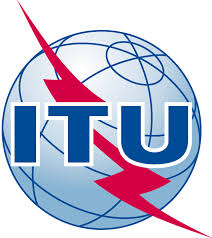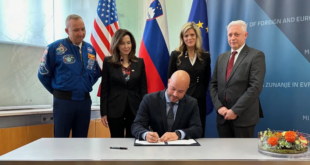 Space and satellites are often treated as an intrinsically exciting and glamorous field of activity. Yet the issue of spectrum requirements, regulatory filings, and spectrum management are all too often considered to be unglamorous, and as a result are unfairly and dangerously ignored. The reality is that without a competent and proper handling of spectrum issues, there are no satellites and space programs.
Space and satellites are often treated as an intrinsically exciting and glamorous field of activity. Yet the issue of spectrum requirements, regulatory filings, and spectrum management are all too often considered to be unglamorous, and as a result are unfairly and dangerously ignored. The reality is that without a competent and proper handling of spectrum issues, there are no satellites and space programs.
SpaceWatch Middle East interviews Swiss-based spectrum expert Hans-Juergen Tscheulin about the importance of spectrum issues for satellite operations, as well as about his extensive experience dealing with Middle Eastern spectrum matters.
How did you get into the career field of dealing with satellite spectrum issues?
Satellite system design and spectrum issues accompanied my professional life during various stages and positions. As a young engineer I worked in the satellite department with Deutsche Telekom AG (formerly known as Deutsche Bundespost). It was the fast growing period of INTELSAT and EUTELSAT. During the national preparation phase for the 1977 World Administrative Radio Conference (WARC 77) we prepared our interest in spectrum demand for satellite communication. Television transmission via satellite and reception of TV programmes with very small dishes was being hyped up and the conference decided to add the very famous Appendix 30 to the Radio Regulation.
During early 1980’s Deutsche Bundespost decided to implement its own national geostationary satellite system called “Kopernikus”, consisting of three satellites. I joined the project group and became responsible with two other engineers for the definition of the payload transmission parameter, the definition of service link budgets, the selection of frequency ranges to be specified, the filing of the system with the International Telecommunications Union (ITU), and the international frequency coordination. For the selection of optimal orbital positions we asked a friendly satellite operator from Canada for a parallel study. The results were very similar and we were pretty sure that our selection of 23.5°E, 28.5°E and 33.5°E would lead to favourable coordination results. This turned out to be true, after many negotiations with several administrations.
The Kopernikus satellites were successfully launched in 1989, 1990 and 1992, and I became an advisor for frequency affairs in the Ministry of Post, Telephone, and Telegraph (PTT) in Riyadh, Saudi Arabia. While in Riyadh, I was asked to review the frequency coordination situation during the very final tender evaluation of the second generation of ARABSAT and I found that some Ku-band frequency ranges would never succeed during the frequency coordination process. I recommended a change which was successfully implemented during the final procurement negotiations.
While employed with Detecon International GmbH I became project manager for the EMARSAT and THURAYA feasibility studies which included topics such as economic viability and the investigation of optimum orbital positions. My group defined the overall THURAYA system, and when the UAE-based company was founded my group prepared the ITU filings, answered to objecting administrations, and we trained the THURAYA staff in all aspects of international frequency coordination. I was later involved in the feasibility and investigation work for the orbital position of PAKSAT-1R. I also worked in the technical and contractual preparation of the fifth generation ARABSAT system, touching on many aspects of frequency coordination while defining the system design and satellite parameters. Lately in 2013 I accepted responsibility as the European Conference on Postal and Telecommunication Administrations (CEPT) coordinator for the 2015 World Radiocommunications Conference (WRC-15) agenda item 1.5, which was to “consider the use of frequency bands allocated to the fixed-satellite service not subject to Appendices 30, 30A and 30B for the control and non-payload communications of unmanned aircraft systems (UAS) in non-segregated airspaces, in accordance with Resolution 153 (WRC12).”
The topic was extremely challenging and accompanied by comprehensive studies, many of them dealing with interference modelling and analyses because of the newly moving earth station on board of remotely piloted aircraft. Finally, WRC-15 opened the way for the development of worldwide standards by the International Civil Aviation Organization (ICAO) for unmanned aircraft systems (UAS), and identified the regulatory conditions that may be applied to such systems internationally.
![Monument in Bern, Switzerland. The text reads: "Union Télégraphique Internationale fondée à Paris en 1865 sur l'initiative du gouvernement français. Érigé par décision de l'Union Télégraphique prise à la conférence internationale de Lisbonne en 1908." (In English: "International Telegraph Union founded at Paris in 1865 on the initiative of the French government. [This monument] erected by a decision of the Telegraph Union made at the international conference at Lisbon in 1908.") Credits: Wikipedia](http://spacewatchme.com/wp-content/uploads/2016/08/640px-ITU_monument_Bern-300x225.jpg)
Why is spectrum management important to the satellite industry – what are the big issues that readers should be aware of?
You are touching on the key issue. Just two years ago I was involved in a project – which is subject to a non-disclosure agreement – where a new operator launched a satellite knowing that half of its Ku-band capacity had nearly no chance of becoming operational – because the neighbouring system with usage priority would stop its service. In cases like this hope is most probably a pointless exercise since the problem is likely to continue throughout the satellite’s lifetime. Instead of a simple satellite system manufacture and delivery, satellite manufacturers should emphasise for small and medium satellite operators support in obtaining useable spectrum. I believe that any other industrial approach is a no-go.
What are the driving issues in the satellite industry with regard to spectrum issues?
- Obtaining the right and proper use of a certain part of the spectrum is the cornerstone for economic success for satellite manufacturers and operators. Small and medium operators face significant disadvantages when defending their spectrum usage against large operators that are filing complex systems and big amounts of data, and requesting large portions of the spectrum.
- The application, allocation, and use of spectrum is underpinned by ambiguous rules. As a matter of fact, geostationary satellite orbit spectrum is mainly used by commercial operators who are typically embedded into deregulated and privatized telecommunications domestic arrangements. However, governments have to acknowledge that application for spectrum and filing of system data follows a process which is based on ITU Radio Regulations (RR) that state that the use of international radio telecommunications should contribute to the economic, cultural and social welfare of humanity (e.g. RR Article 44).
- Experts say that approximately fifty per-cent or more satellites are being built for launch from 2011-2020 than during the previous decade. Yet existing spectrum is being squeezed and operators are urged to take frequency coordination aspects into account at early system design phases through improved antenna shaping, use of agile transmission techniques, improved ground stations, and so on. Such design and architectural trade-offs are not free of charge. In addition, transmission operation, line-up procedures, and corresponding staff training should emphasize avoidance of interference with other satellite systems.
- The Golden Age of linear and inflexible service profiles will disappear. Satellite operators are talking about high throughput satellites (HTS), serving the internet of things (IoT), about extremely flexible digital payloads to react quickly to changing demands, providing 4G communication into airplanes and providing broadband services to clients. But rapidly changing usage profiles and flexible spectrum allocation will increase the effort to ensure seamless and effective control of the interference environment and will contribute to the cost and efforts for the future frequency coordination process.
- So-called Paper Tiger satellite systems place hurdles on the deployment of new satellite systems or modifications of existing systems. The ITU procedure of “first-come-first-serve” is not the best approach but even after decades of discussion there is no other alternative way of doing things more fairly and efficiently, so we have to live with this reality. Some governments go through a qualification procedure before satellite operator data are submitted to the ITU in order to maintain their national spectrum strategy. Many other governments have no qualification process at all, and as a result unaudited, unreviewed and unrevised applications are filed with the ITU. The filtering instruments of ITU – such as the time constraint for putting a satellite system into service, filing costs, and so forth – are working but are as weak as ITU member states want them to be. Satellite operators together with manufacturers must take these hurdles into account when they start system designs.
In your professional opinion, what are the satellite spectrum issues for Middle East satellite operators, and how can these issues be resolved?
This is an interesting question.
First of all, it must be mentioned that spectrum policy is a permanent task of the Arab Spectrum Management Group (ASMG), whose task is mainly to gather the spectrum interests of the various Arab governments and regional or national organisations and to create – a much as possible – consensus on the upcoming WRC-19 agenda items as a regional organisation. ASMG has its own voice and reputation at the WRC’s and its input is taken seriously and are always valid. Of course, the ASMG deals with all types of spectrum issues and services, and through regular exchanges of views and opinions with other regional groups in Europe, Africa, Asia and America the discussions on proposed changes to spectrum allocations or procedures are always up to date.
Just a few weeks ago the Telecommunications Regulatory Authority (TRA) in the United Arab Emirates was elected to head the next ASMG preparation cycle for WRC-19.
From my experience, I see two major topics with regard to spectrum issues in the Middle East:
- A belief in permanent spectrum growth may mislead satellite operators to close their eyes to changes underway that should not be ignored. Nearly twenty satellite operators are currently active and deploy services all over the Middle East, according to Euroconsult. This means operators are facing fierce competition in the Middle East, while the geographical battlefield is quite larger than the Middle East. Many operators have facilitated fruitful horizontal and vertical co-operation enabling service providers to perform and offer excellent services to end customers. Maintaining a presence in the complete value chain has become important. So far so good. But powerful new players are showing up on the horizon with ambitious plans:
- OneWeb’s constellation of 648 satellites circling the Earth will enable affordable internet access;
- SpaceX will deploy a constellation of 4,000 broadband satellites weighing a few hundred kilograms each and orbiting at 1,100-km (683-mi.) altitude;
Two big global operators have already put a foot in the door of medium- and low-earth orbit satellite networks:
- Luxembourg-based SES owns O3B, which is a medium-Earth-orbit network comprising 12 Ka-band satellites offering broadband internet;
- Intelsat has already made a cash investment of US$25 million in OneWeb to better serve its maritime and aeronautical sectors
The new players may face potential interference issues around the equator, and any interference has to be resolved in favour of the established operators. For example, OneWeb has announced many times that it will not cause interference with existing systems. Intelsat is optimistic that there are new opportunities to solve spectrum congestion through operational methods. Many other large geostationary satellite operators are less confident, and expect difficult discussions in the future because they are quite sure that interference with existing systems cannot be avoided.
Middle East satellite operators should take these new enterprises seriously and decide to what extent they want to resist or cooperate.
Lastly, intentional jamming is still a big problem for Middle East operators. Some years ago I was involved in supporting a Middle East satellite operator to find the source of a jamming incident. Many monitoring results were analysed and we were able to state that the jamming earth station location was within a certain area with high probability. The timeliness of the jamming problem was confirmed during the 2016 Global Space Conference on Space and Information Society through the contribution from the British Broadcasting Corporation (BBC). Middle East operators might consider establishing a task group that establishes the quick exchange of jamming incident data into a common database, including regular assessments of potential jamming source locations. This task group could also develop mitigation measures and recommendations on how to improve satellite transmission against jamming.
Biography:

Hans Juergen Tscheulin is a business advisor with extensive experience and management skills, and operates his own consulting company located in Switzerland. He supports high-tech projects and works for the telecommunications industry. He advises international satellite operators with respect to system definition, procurement, regulatory situation and project monitoring. He worked as European Coordinator for a WRC-15 agenda item and has held various positions in senior management in several countries. His sound technical and business advice has enabled clients to efficiently set-up new systems and services, as well as change and adapt to a changing regulatory environment. Hans Juergen Tscheulin was educated in Germany and has a diploma in communication engineering.
Original published at: http://spacewatchme.com/2016/08/satellite-spectrum-issues-middle-east-interview-hans-juergen-tscheulin/
 SpaceWatch.Global An independent perspective on space
SpaceWatch.Global An independent perspective on space

